Perspective 1: Analyzing the Portrayal of Femininity in Dorothy’s Costume
Dorothy’s costume portrays a traditional and nostalgic representation of femininity, reflecting the societal expectations of the time. The blue and white gingham dress is often associated with innocence and purity, aligning with the conventional ideals of femininity. The dress’s modest cut and playful pigtails accentuate Dorothy’s youthful and girlish qualities, emphasizing her femininity in a manner that was deemed appropriate and acceptable.
The costume’s depiction of femininity serves to humanize and endear Dorothy to the audience, making her relatable and accessible as a character. The innocence and simplicity associated with her costume evoke a sense of nostalgia, tapping into traditional notions of femininity that were prevalent during the era. It is important to recognize, however, that this portrayal is reflective of its time and may not encompass the full breadth of female expression and identity.
Perspective 2: Discussing the Traditional Gender Roles Depicted through the Costume
Dorothy’s costume reflects the traditional gender roles that were prevalent during the time the film was released. The dress and its accompanying accessories align with the expectation that women should embody qualities such as gentleness, modesty, and domesticity. This echoes the societal norm that women were primarily expected to be nurturers and caretakers.
The costume reinforces the notion of femininity being associated with innocence and vulnerability, as Dorothy’s character often relies on others for protection and guidance. It reflects the gendered expectations placed upon women to be dependent and submissive, conforming to societal norms and roles.
Perspective 3: Examining the Impact of Dorothy’s Costume on Gender Expectations and Stereotypes
Dorothy’s costume has had a significant impact on perpetuating and challenging gender expectations and stereotypes. On one hand, the costume reinforces traditional gender roles by presenting Dorothy as a damsel in distress who must rely on external forces for her well-being. This perpetuates the notion that women are inherently weaker and need protection.
However, on the other hand, the costume can also be seen as empowering. Dorothy’s character defies expectations through her agency, strength, and resilience. Despite being portrayed within traditional gender roles, Dorothy challenges these expectations by taking charge of her own narrative and exhibiting qualities typically associated with heroism and leadership.
The impact of Dorothy’s costume on gender expectations and stereotypes is not limited to the film itself. The character of Dorothy, with her iconic costume, has become a cultural symbol that has permeated various forms of media and popular culture. This enduring influence has provided an opportunity for further examination and discussion of gender roles, inspiring conversations about female agency, empowerment, and the limitations and expectations placed on women.
Perspective 4: Exploring Feminist Interpretations of Dorothy’s Character and Costume
Feminist interpretations of Dorothy’s character and costume highlight the potential for subversion and empowerment. While the costume aligns with traditional gender roles, Dorothy’s character defies expectations through her agency, strength, and resilience. She becomes a symbol of female empowerment, as her journey challenges societal norms and allows her to discover her own capabilities.
Dorothy’s costume can be viewed as a tool for reclaiming and redefining femininity. Through her costume, Dorothy showcases that femininity can coexist with courage, independence, and self-determination. It becomes a visual reminder that femininity does not equate to weakness, but rather encompasses a spectrum of strengths and qualities.
Feminist interpretations of Dorothy’s character and costume highlight the potential for subversion and redefinition of femininity. By defying traditional gender roles and expectations, Dorothy becomes a symbol of female empowerment and challenges notions of femininity as limited or submissive. The costume serves as a visual representation of this empowerment, reminding viewers that femininity encompasses strength, agency, and resilience.
In conclusion, Dorothy’s costume reflects a traditional portrayal of femininity, aligning with societal expectations of the time. It perpetuates traditional gender roles by emphasizing qualities associated with innocence, vulnerability, and dependence. However, the costume also provides opportunities for empowerment and challenges gender expectations, as Dorothy’s character defies societal norms and showcases strength and resilience. Feminist interpretations of Dorothy’s character and costume highlight the potential for subversion and redefinition of femininity, allowing for a broader understanding of female identity and agency.
